CX663611 Managerial Decision Processes: Problem Solving Models & Puti
VerifiedAdded on 2023/04/20
|8
|1924
|453
Project
AI Summary
This project proposal investigates the influence of problem-solving models on 'Puti,' an Auckland-based clothing store facing business challenges. It defines problem-solving models, explains their usage, and outlines various models like brainstorming, fishbone diagrams, 5 Whys analysis, and SWOT analysis. The proposal details how these models can be applied to Puti's specific issues to identify, analyze, and mitigate risks, ultimately enhancing the organization's problem-solving capabilities. The document also references the CX663611 Managerial Decision Processes course at Auckland International Campus.
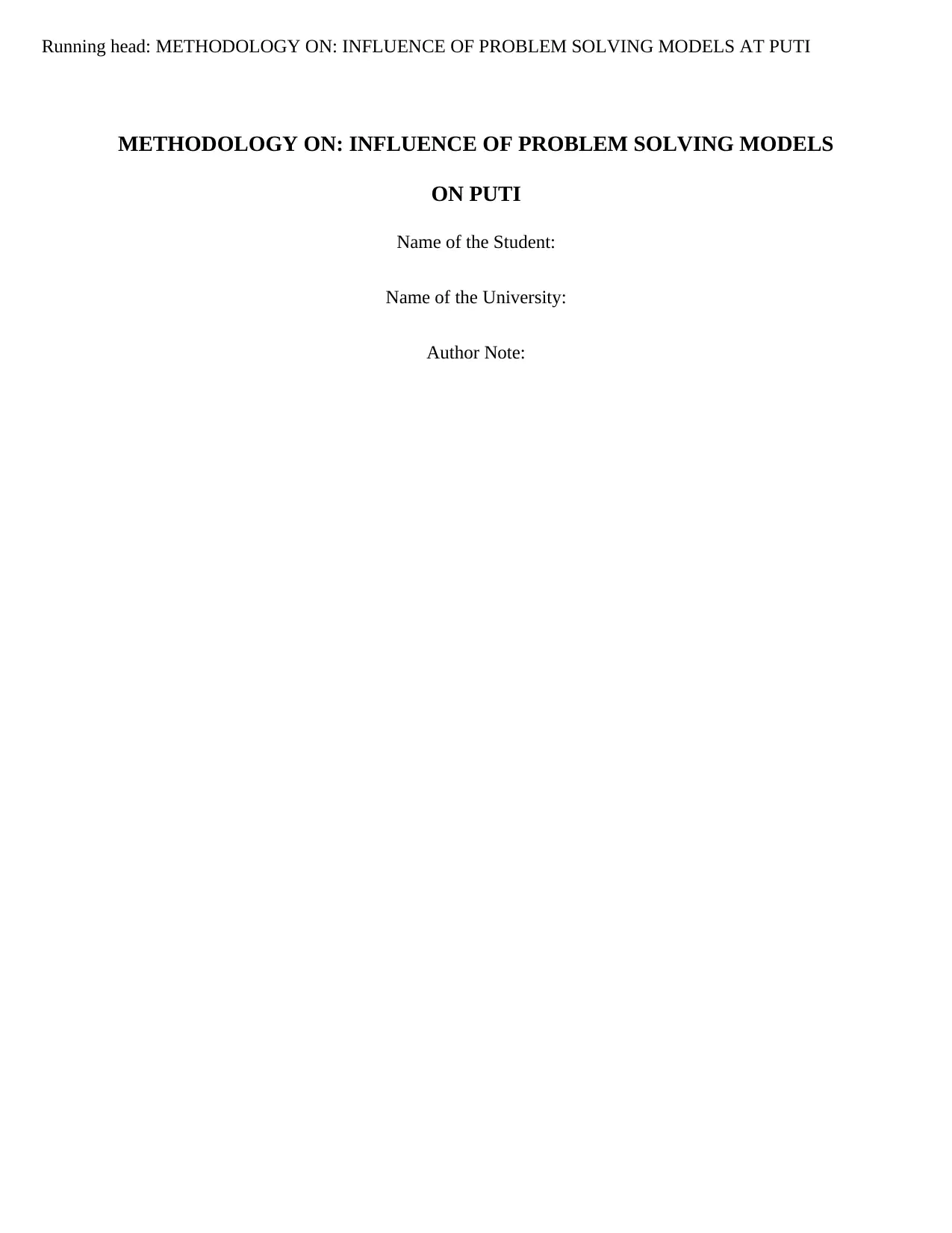
Running head: METHODOLOGY ON: INFLUENCE OF PROBLEM SOLVING MODELS AT PUTI
METHODOLOGY ON: INFLUENCE OF PROBLEM SOLVING MODELS
ON PUTI
Name of the Student:
Name of the University:
Author Note:
METHODOLOGY ON: INFLUENCE OF PROBLEM SOLVING MODELS
ON PUTI
Name of the Student:
Name of the University:
Author Note:
Paraphrase This Document
Need a fresh take? Get an instant paraphrase of this document with our AI Paraphraser
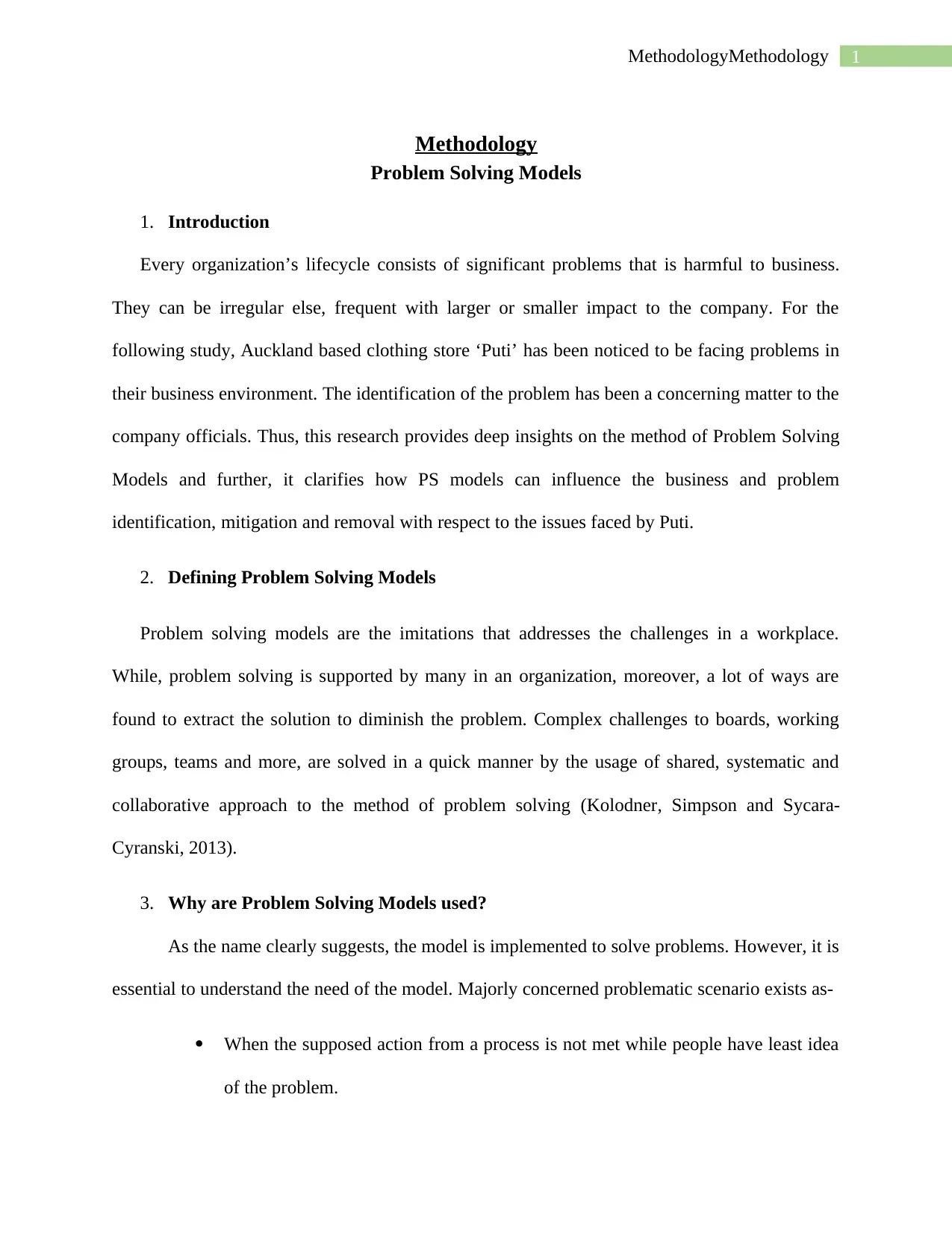
1MethodologyMethodology
Methodology
Problem Solving Models
1. Introduction
Every organization’s lifecycle consists of significant problems that is harmful to business.
They can be irregular else, frequent with larger or smaller impact to the company. For the
following study, Auckland based clothing store ‘Puti’ has been noticed to be facing problems in
their business environment. The identification of the problem has been a concerning matter to the
company officials. Thus, this research provides deep insights on the method of Problem Solving
Models and further, it clarifies how PS models can influence the business and problem
identification, mitigation and removal with respect to the issues faced by Puti.
2. Defining Problem Solving Models
Problem solving models are the imitations that addresses the challenges in a workplace.
While, problem solving is supported by many in an organization, moreover, a lot of ways are
found to extract the solution to diminish the problem. Complex challenges to boards, working
groups, teams and more, are solved in a quick manner by the usage of shared, systematic and
collaborative approach to the method of problem solving (Kolodner, Simpson and Sycara-
Cyranski, 2013).
3. Why are Problem Solving Models used?
As the name clearly suggests, the model is implemented to solve problems. However, it is
essential to understand the need of the model. Majorly concerned problematic scenario exists as-
When the supposed action from a process is not met while people have least idea
of the problem.
Methodology
Problem Solving Models
1. Introduction
Every organization’s lifecycle consists of significant problems that is harmful to business.
They can be irregular else, frequent with larger or smaller impact to the company. For the
following study, Auckland based clothing store ‘Puti’ has been noticed to be facing problems in
their business environment. The identification of the problem has been a concerning matter to the
company officials. Thus, this research provides deep insights on the method of Problem Solving
Models and further, it clarifies how PS models can influence the business and problem
identification, mitigation and removal with respect to the issues faced by Puti.
2. Defining Problem Solving Models
Problem solving models are the imitations that addresses the challenges in a workplace.
While, problem solving is supported by many in an organization, moreover, a lot of ways are
found to extract the solution to diminish the problem. Complex challenges to boards, working
groups, teams and more, are solved in a quick manner by the usage of shared, systematic and
collaborative approach to the method of problem solving (Kolodner, Simpson and Sycara-
Cyranski, 2013).
3. Why are Problem Solving Models used?
As the name clearly suggests, the model is implemented to solve problems. However, it is
essential to understand the need of the model. Majorly concerned problematic scenario exists as-
When the supposed action from a process is not met while people have least idea
of the problem.
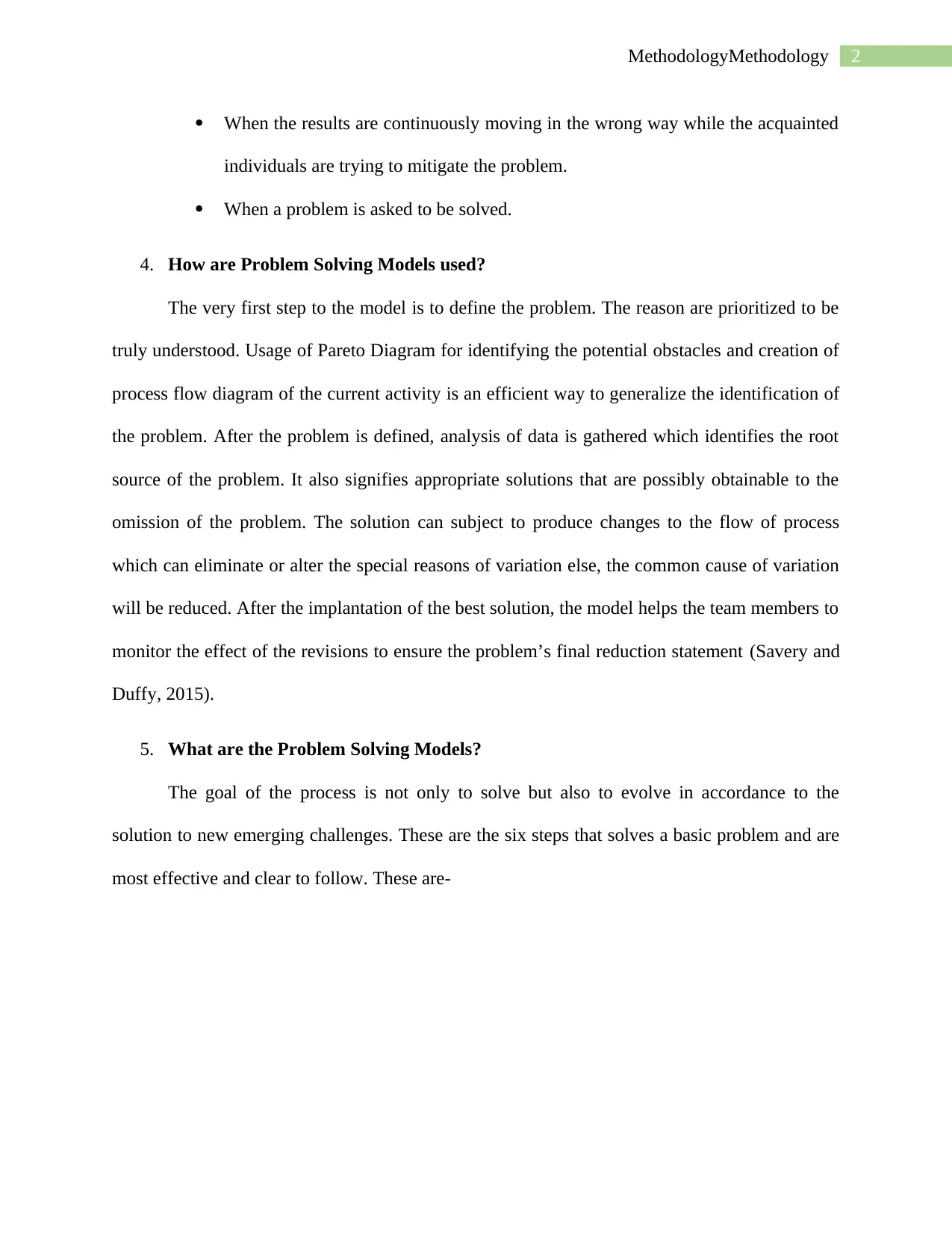
2MethodologyMethodology
When the results are continuously moving in the wrong way while the acquainted
individuals are trying to mitigate the problem.
When a problem is asked to be solved.
4. How are Problem Solving Models used?
The very first step to the model is to define the problem. The reason are prioritized to be
truly understood. Usage of Pareto Diagram for identifying the potential obstacles and creation of
process flow diagram of the current activity is an efficient way to generalize the identification of
the problem. After the problem is defined, analysis of data is gathered which identifies the root
source of the problem. It also signifies appropriate solutions that are possibly obtainable to the
omission of the problem. The solution can subject to produce changes to the flow of process
which can eliminate or alter the special reasons of variation else, the common cause of variation
will be reduced. After the implantation of the best solution, the model helps the team members to
monitor the effect of the revisions to ensure the problem’s final reduction statement (Savery and
Duffy, 2015).
5. What are the Problem Solving Models?
The goal of the process is not only to solve but also to evolve in accordance to the
solution to new emerging challenges. These are the six steps that solves a basic problem and are
most effective and clear to follow. These are-
When the results are continuously moving in the wrong way while the acquainted
individuals are trying to mitigate the problem.
When a problem is asked to be solved.
4. How are Problem Solving Models used?
The very first step to the model is to define the problem. The reason are prioritized to be
truly understood. Usage of Pareto Diagram for identifying the potential obstacles and creation of
process flow diagram of the current activity is an efficient way to generalize the identification of
the problem. After the problem is defined, analysis of data is gathered which identifies the root
source of the problem. It also signifies appropriate solutions that are possibly obtainable to the
omission of the problem. The solution can subject to produce changes to the flow of process
which can eliminate or alter the special reasons of variation else, the common cause of variation
will be reduced. After the implantation of the best solution, the model helps the team members to
monitor the effect of the revisions to ensure the problem’s final reduction statement (Savery and
Duffy, 2015).
5. What are the Problem Solving Models?
The goal of the process is not only to solve but also to evolve in accordance to the
solution to new emerging challenges. These are the six steps that solves a basic problem and are
most effective and clear to follow. These are-
⊘ This is a preview!⊘
Do you want full access?
Subscribe today to unlock all pages.

Trusted by 1+ million students worldwide
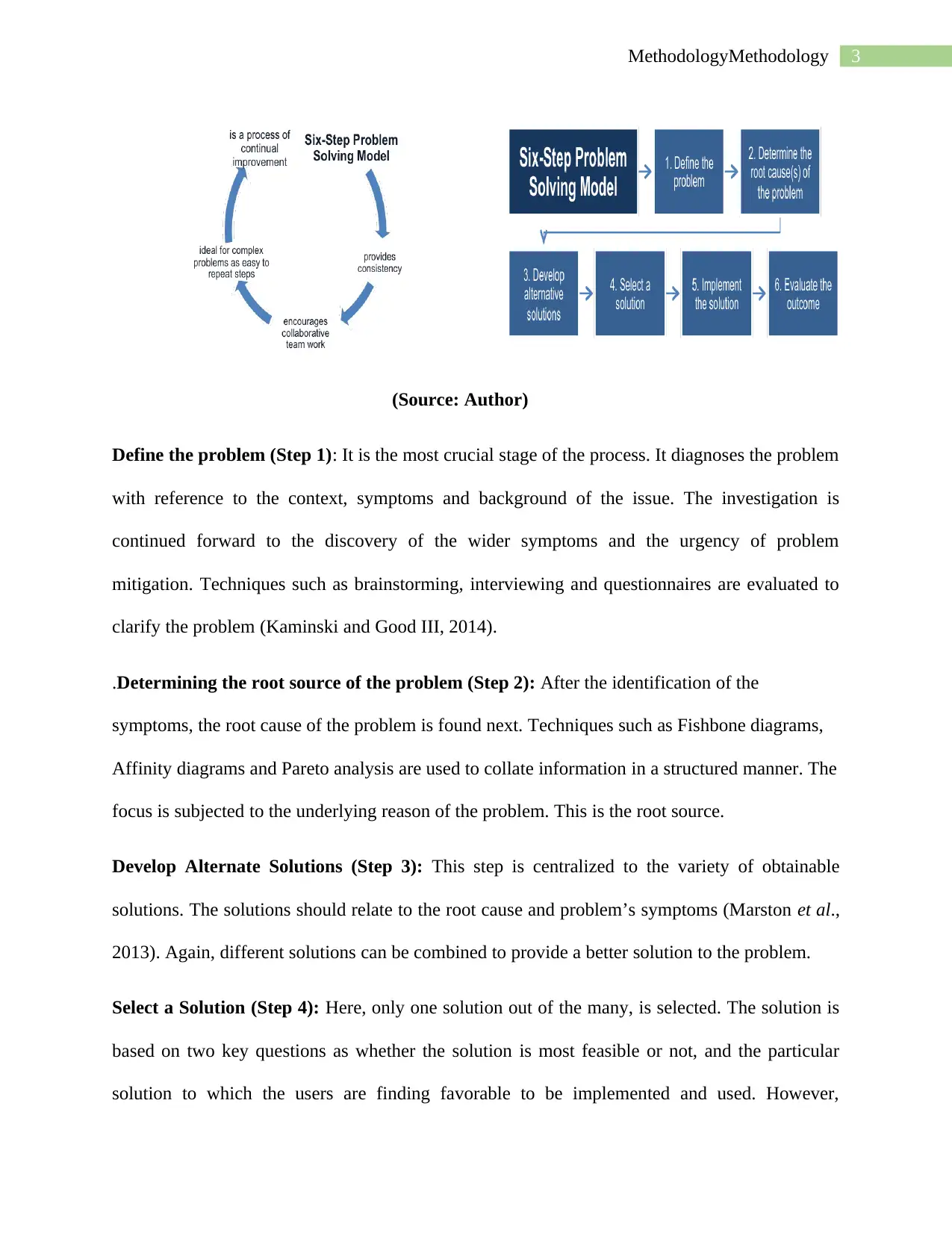
3MethodologyMethodology
(Source: Author)
Define the problem (Step 1): It is the most crucial stage of the process. It diagnoses the problem
with reference to the context, symptoms and background of the issue. The investigation is
continued forward to the discovery of the wider symptoms and the urgency of problem
mitigation. Techniques such as brainstorming, interviewing and questionnaires are evaluated to
clarify the problem (Kaminski and Good III, 2014).
.Determining the root source of the problem (Step 2): After the identification of the
symptoms, the root cause of the problem is found next. Techniques such as Fishbone diagrams,
Affinity diagrams and Pareto analysis are used to collate information in a structured manner. The
focus is subjected to the underlying reason of the problem. This is the root source.
Develop Alternate Solutions (Step 3): This step is centralized to the variety of obtainable
solutions. The solutions should relate to the root cause and problem’s symptoms (Marston et al.,
2013). Again, different solutions can be combined to provide a better solution to the problem.
Select a Solution (Step 4): Here, only one solution out of the many, is selected. The solution is
based on two key questions as whether the solution is most feasible or not, and the particular
solution to which the users are finding favorable to be implemented and used. However,
(Source: Author)
Define the problem (Step 1): It is the most crucial stage of the process. It diagnoses the problem
with reference to the context, symptoms and background of the issue. The investigation is
continued forward to the discovery of the wider symptoms and the urgency of problem
mitigation. Techniques such as brainstorming, interviewing and questionnaires are evaluated to
clarify the problem (Kaminski and Good III, 2014).
.Determining the root source of the problem (Step 2): After the identification of the
symptoms, the root cause of the problem is found next. Techniques such as Fishbone diagrams,
Affinity diagrams and Pareto analysis are used to collate information in a structured manner. The
focus is subjected to the underlying reason of the problem. This is the root source.
Develop Alternate Solutions (Step 3): This step is centralized to the variety of obtainable
solutions. The solutions should relate to the root cause and problem’s symptoms (Marston et al.,
2013). Again, different solutions can be combined to provide a better solution to the problem.
Select a Solution (Step 4): Here, only one solution out of the many, is selected. The solution is
based on two key questions as whether the solution is most feasible or not, and the particular
solution to which the users are finding favorable to be implemented and used. However,
Paraphrase This Document
Need a fresh take? Get an instant paraphrase of this document with our AI Paraphraser
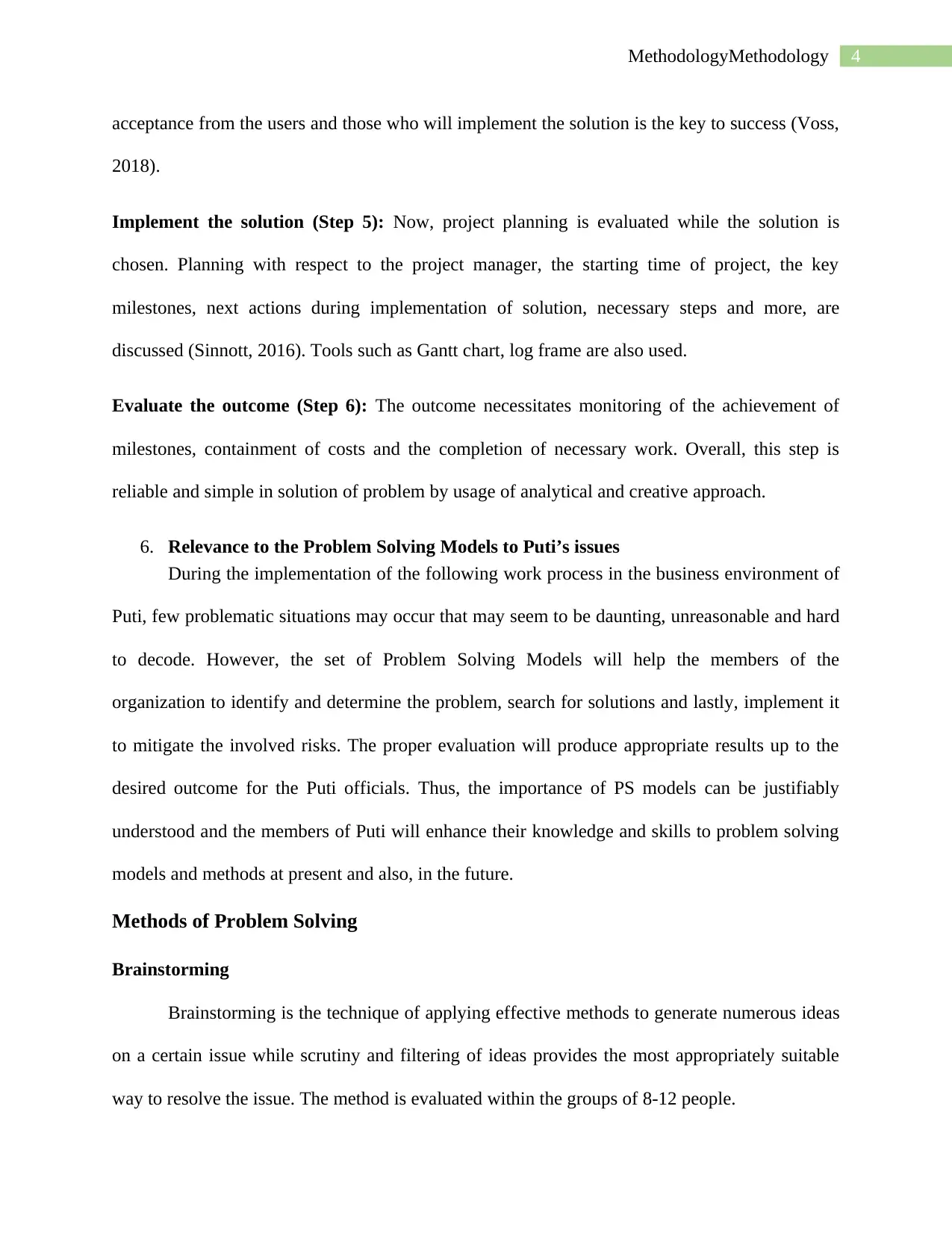
4MethodologyMethodology
acceptance from the users and those who will implement the solution is the key to success (Voss,
2018).
Implement the solution (Step 5): Now, project planning is evaluated while the solution is
chosen. Planning with respect to the project manager, the starting time of project, the key
milestones, next actions during implementation of solution, necessary steps and more, are
discussed (Sinnott, 2016). Tools such as Gantt chart, log frame are also used.
Evaluate the outcome (Step 6): The outcome necessitates monitoring of the achievement of
milestones, containment of costs and the completion of necessary work. Overall, this step is
reliable and simple in solution of problem by usage of analytical and creative approach.
6. Relevance to the Problem Solving Models to Puti’s issues
During the implementation of the following work process in the business environment of
Puti, few problematic situations may occur that may seem to be daunting, unreasonable and hard
to decode. However, the set of Problem Solving Models will help the members of the
organization to identify and determine the problem, search for solutions and lastly, implement it
to mitigate the involved risks. The proper evaluation will produce appropriate results up to the
desired outcome for the Puti officials. Thus, the importance of PS models can be justifiably
understood and the members of Puti will enhance their knowledge and skills to problem solving
models and methods at present and also, in the future.
Methods of Problem Solving
Brainstorming
Brainstorming is the technique of applying effective methods to generate numerous ideas
on a certain issue while scrutiny and filtering of ideas provides the most appropriately suitable
way to resolve the issue. The method is evaluated within the groups of 8-12 people.
acceptance from the users and those who will implement the solution is the key to success (Voss,
2018).
Implement the solution (Step 5): Now, project planning is evaluated while the solution is
chosen. Planning with respect to the project manager, the starting time of project, the key
milestones, next actions during implementation of solution, necessary steps and more, are
discussed (Sinnott, 2016). Tools such as Gantt chart, log frame are also used.
Evaluate the outcome (Step 6): The outcome necessitates monitoring of the achievement of
milestones, containment of costs and the completion of necessary work. Overall, this step is
reliable and simple in solution of problem by usage of analytical and creative approach.
6. Relevance to the Problem Solving Models to Puti’s issues
During the implementation of the following work process in the business environment of
Puti, few problematic situations may occur that may seem to be daunting, unreasonable and hard
to decode. However, the set of Problem Solving Models will help the members of the
organization to identify and determine the problem, search for solutions and lastly, implement it
to mitigate the involved risks. The proper evaluation will produce appropriate results up to the
desired outcome for the Puti officials. Thus, the importance of PS models can be justifiably
understood and the members of Puti will enhance their knowledge and skills to problem solving
models and methods at present and also, in the future.
Methods of Problem Solving
Brainstorming
Brainstorming is the technique of applying effective methods to generate numerous ideas
on a certain issue while scrutiny and filtering of ideas provides the most appropriately suitable
way to resolve the issue. The method is evaluated within the groups of 8-12 people.
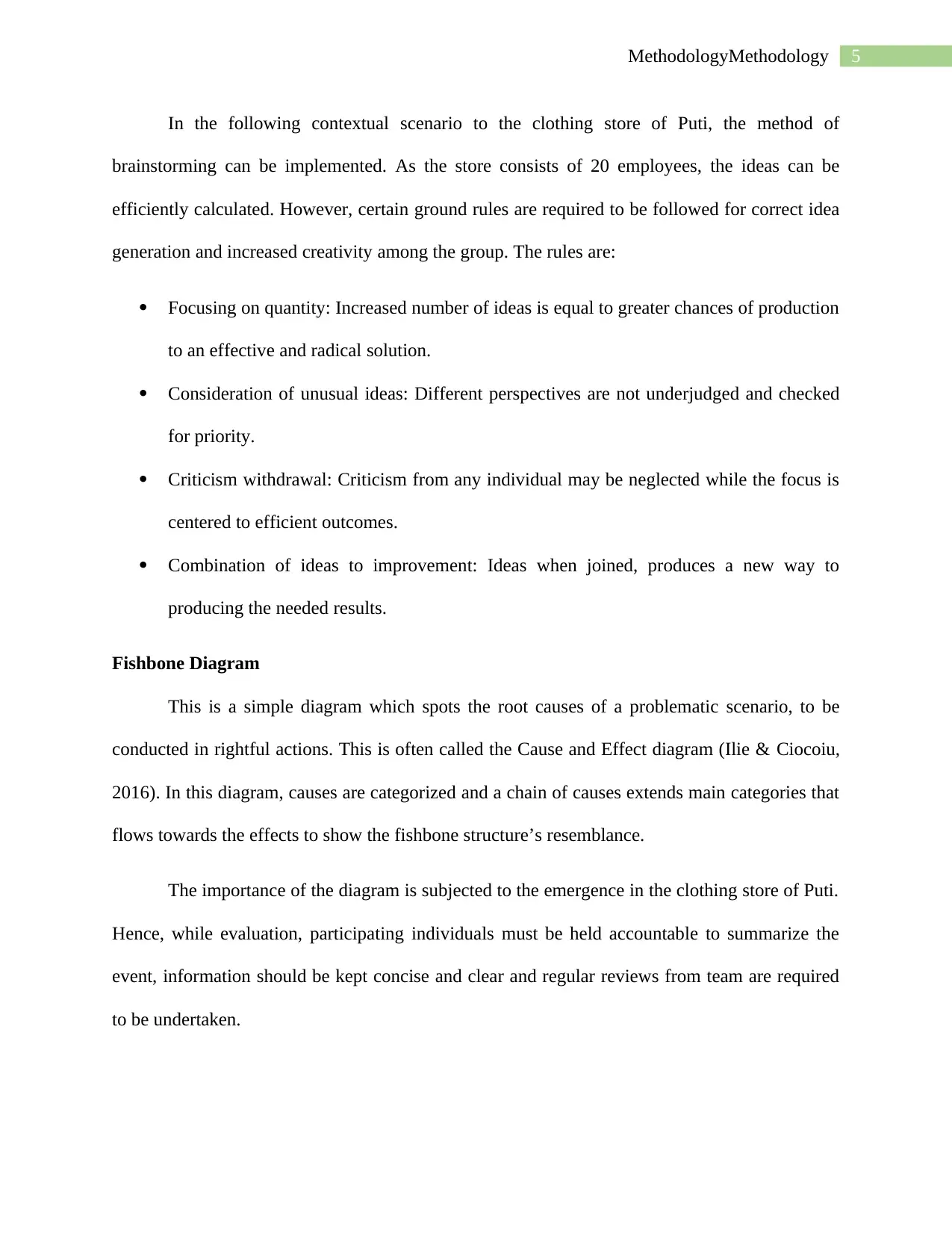
5MethodologyMethodology
In the following contextual scenario to the clothing store of Puti, the method of
brainstorming can be implemented. As the store consists of 20 employees, the ideas can be
efficiently calculated. However, certain ground rules are required to be followed for correct idea
generation and increased creativity among the group. The rules are:
Focusing on quantity: Increased number of ideas is equal to greater chances of production
to an effective and radical solution.
Consideration of unusual ideas: Different perspectives are not underjudged and checked
for priority.
Criticism withdrawal: Criticism from any individual may be neglected while the focus is
centered to efficient outcomes.
Combination of ideas to improvement: Ideas when joined, produces a new way to
producing the needed results.
Fishbone Diagram
This is a simple diagram which spots the root causes of a problematic scenario, to be
conducted in rightful actions. This is often called the Cause and Effect diagram (Ilie & Ciocoiu,
2016). In this diagram, causes are categorized and a chain of causes extends main categories that
flows towards the effects to show the fishbone structure’s resemblance.
The importance of the diagram is subjected to the emergence in the clothing store of Puti.
Hence, while evaluation, participating individuals must be held accountable to summarize the
event, information should be kept concise and clear and regular reviews from team are required
to be undertaken.
In the following contextual scenario to the clothing store of Puti, the method of
brainstorming can be implemented. As the store consists of 20 employees, the ideas can be
efficiently calculated. However, certain ground rules are required to be followed for correct idea
generation and increased creativity among the group. The rules are:
Focusing on quantity: Increased number of ideas is equal to greater chances of production
to an effective and radical solution.
Consideration of unusual ideas: Different perspectives are not underjudged and checked
for priority.
Criticism withdrawal: Criticism from any individual may be neglected while the focus is
centered to efficient outcomes.
Combination of ideas to improvement: Ideas when joined, produces a new way to
producing the needed results.
Fishbone Diagram
This is a simple diagram which spots the root causes of a problematic scenario, to be
conducted in rightful actions. This is often called the Cause and Effect diagram (Ilie & Ciocoiu,
2016). In this diagram, causes are categorized and a chain of causes extends main categories that
flows towards the effects to show the fishbone structure’s resemblance.
The importance of the diagram is subjected to the emergence in the clothing store of Puti.
Hence, while evaluation, participating individuals must be held accountable to summarize the
event, information should be kept concise and clear and regular reviews from team are required
to be undertaken.
⊘ This is a preview!⊘
Do you want full access?
Subscribe today to unlock all pages.

Trusted by 1+ million students worldwide
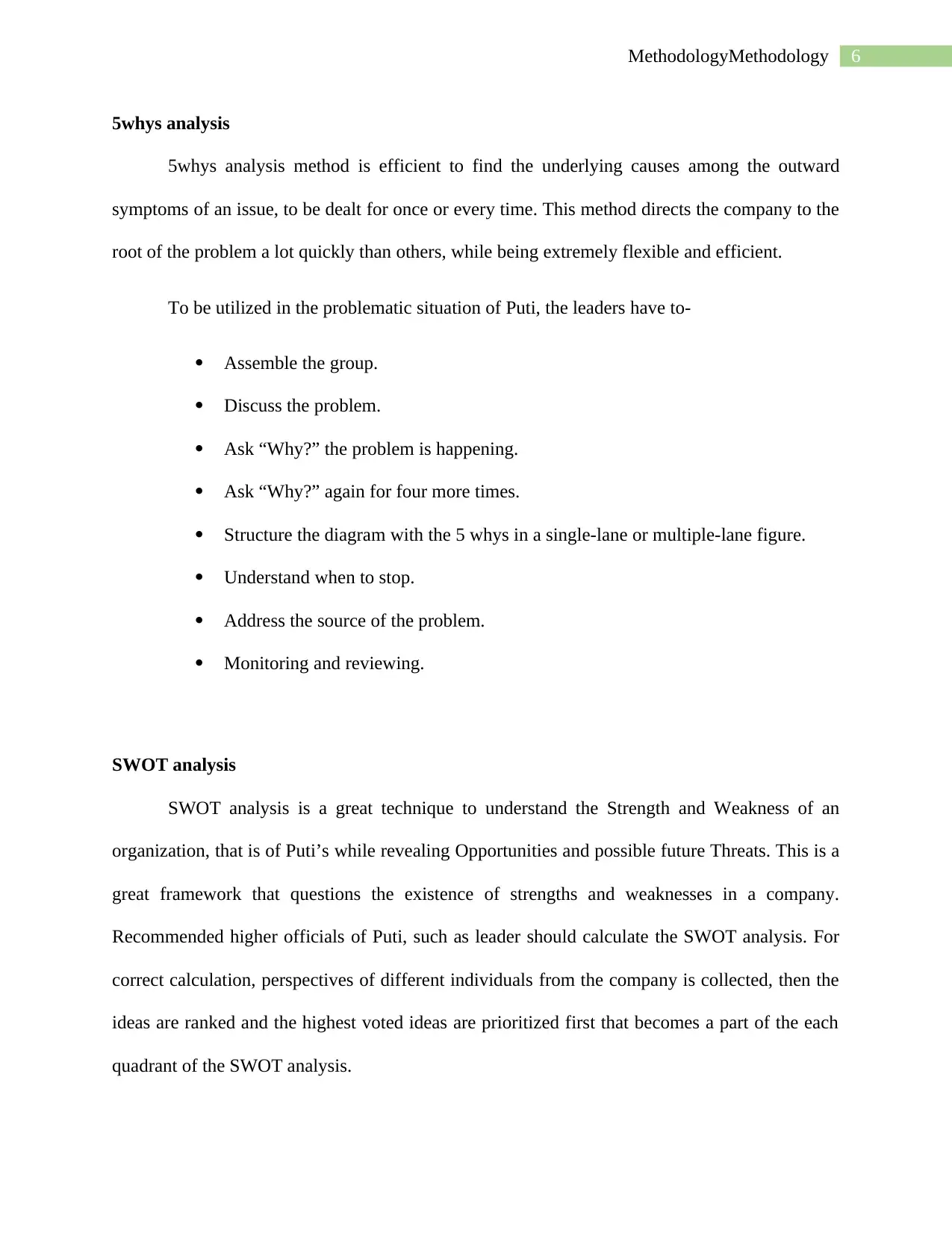
6MethodologyMethodology
5whys analysis
5whys analysis method is efficient to find the underlying causes among the outward
symptoms of an issue, to be dealt for once or every time. This method directs the company to the
root of the problem a lot quickly than others, while being extremely flexible and efficient.
To be utilized in the problematic situation of Puti, the leaders have to-
Assemble the group.
Discuss the problem.
Ask “Why?” the problem is happening.
Ask “Why?” again for four more times.
Structure the diagram with the 5 whys in a single-lane or multiple-lane figure.
Understand when to stop.
Address the source of the problem.
Monitoring and reviewing.
SWOT analysis
SWOT analysis is a great technique to understand the Strength and Weakness of an
organization, that is of Puti’s while revealing Opportunities and possible future Threats. This is a
great framework that questions the existence of strengths and weaknesses in a company.
Recommended higher officials of Puti, such as leader should calculate the SWOT analysis. For
correct calculation, perspectives of different individuals from the company is collected, then the
ideas are ranked and the highest voted ideas are prioritized first that becomes a part of the each
quadrant of the SWOT analysis.
5whys analysis
5whys analysis method is efficient to find the underlying causes among the outward
symptoms of an issue, to be dealt for once or every time. This method directs the company to the
root of the problem a lot quickly than others, while being extremely flexible and efficient.
To be utilized in the problematic situation of Puti, the leaders have to-
Assemble the group.
Discuss the problem.
Ask “Why?” the problem is happening.
Ask “Why?” again for four more times.
Structure the diagram with the 5 whys in a single-lane or multiple-lane figure.
Understand when to stop.
Address the source of the problem.
Monitoring and reviewing.
SWOT analysis
SWOT analysis is a great technique to understand the Strength and Weakness of an
organization, that is of Puti’s while revealing Opportunities and possible future Threats. This is a
great framework that questions the existence of strengths and weaknesses in a company.
Recommended higher officials of Puti, such as leader should calculate the SWOT analysis. For
correct calculation, perspectives of different individuals from the company is collected, then the
ideas are ranked and the highest voted ideas are prioritized first that becomes a part of the each
quadrant of the SWOT analysis.
Paraphrase This Document
Need a fresh take? Get an instant paraphrase of this document with our AI Paraphraser
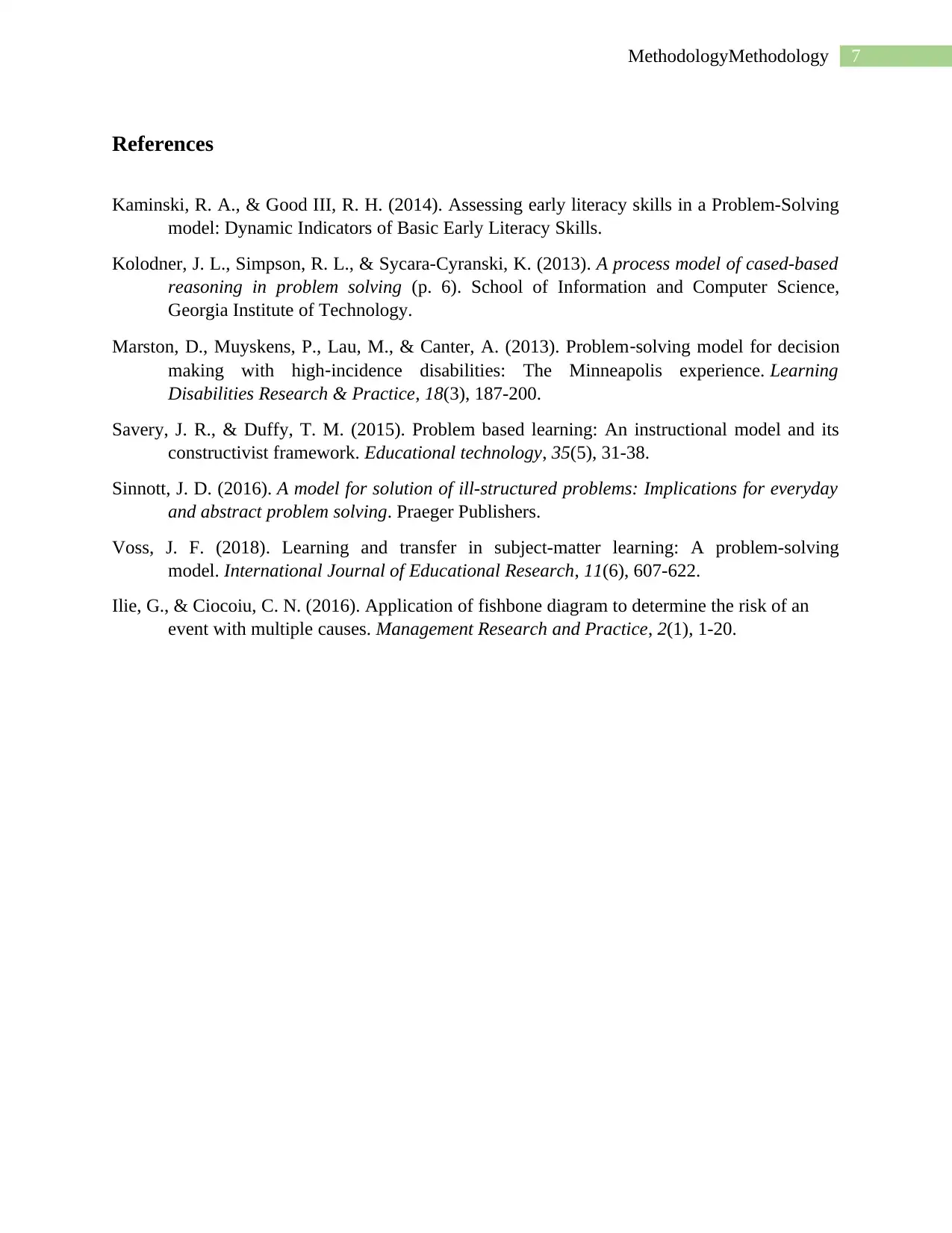
7MethodologyMethodology
References
Kaminski, R. A., & Good III, R. H. (2014). Assessing early literacy skills in a Problem-Solving
model: Dynamic Indicators of Basic Early Literacy Skills.
Kolodner, J. L., Simpson, R. L., & Sycara-Cyranski, K. (2013). A process model of cased-based
reasoning in problem solving (p. 6). School of Information and Computer Science,
Georgia Institute of Technology.
Marston, D., Muyskens, P., Lau, M., & Canter, A. (2013). Problem‐solving model for decision
making with high‐incidence disabilities: The Minneapolis experience. Learning
Disabilities Research & Practice, 18(3), 187-200.
Savery, J. R., & Duffy, T. M. (2015). Problem based learning: An instructional model and its
constructivist framework. Educational technology, 35(5), 31-38.
Sinnott, J. D. (2016). A model for solution of ill-structured problems: Implications for everyday
and abstract problem solving. Praeger Publishers.
Voss, J. F. (2018). Learning and transfer in subject-matter learning: A problem-solving
model. International Journal of Educational Research, 11(6), 607-622.
Ilie, G., & Ciocoiu, C. N. (2016). Application of fishbone diagram to determine the risk of an
event with multiple causes. Management Research and Practice, 2(1), 1-20.
References
Kaminski, R. A., & Good III, R. H. (2014). Assessing early literacy skills in a Problem-Solving
model: Dynamic Indicators of Basic Early Literacy Skills.
Kolodner, J. L., Simpson, R. L., & Sycara-Cyranski, K. (2013). A process model of cased-based
reasoning in problem solving (p. 6). School of Information and Computer Science,
Georgia Institute of Technology.
Marston, D., Muyskens, P., Lau, M., & Canter, A. (2013). Problem‐solving model for decision
making with high‐incidence disabilities: The Minneapolis experience. Learning
Disabilities Research & Practice, 18(3), 187-200.
Savery, J. R., & Duffy, T. M. (2015). Problem based learning: An instructional model and its
constructivist framework. Educational technology, 35(5), 31-38.
Sinnott, J. D. (2016). A model for solution of ill-structured problems: Implications for everyday
and abstract problem solving. Praeger Publishers.
Voss, J. F. (2018). Learning and transfer in subject-matter learning: A problem-solving
model. International Journal of Educational Research, 11(6), 607-622.
Ilie, G., & Ciocoiu, C. N. (2016). Application of fishbone diagram to determine the risk of an
event with multiple causes. Management Research and Practice, 2(1), 1-20.
1 out of 8
Related Documents
Your All-in-One AI-Powered Toolkit for Academic Success.
+13062052269
info@desklib.com
Available 24*7 on WhatsApp / Email
![[object Object]](/_next/static/media/star-bottom.7253800d.svg)
Unlock your academic potential
Copyright © 2020–2025 A2Z Services. All Rights Reserved. Developed and managed by ZUCOL.





